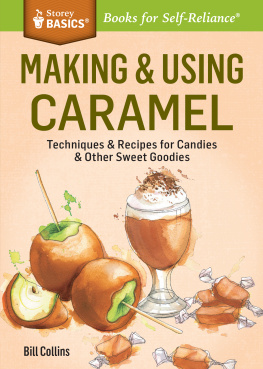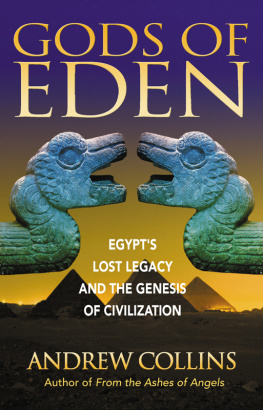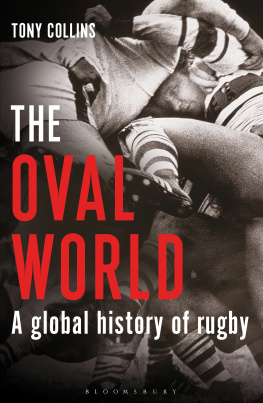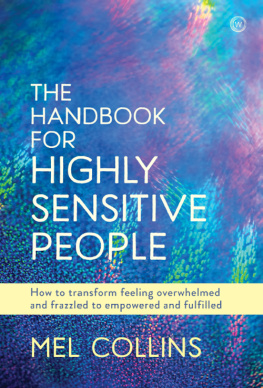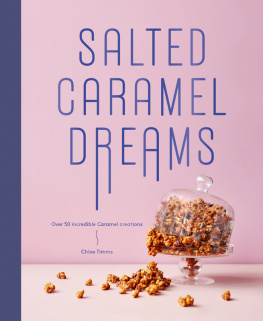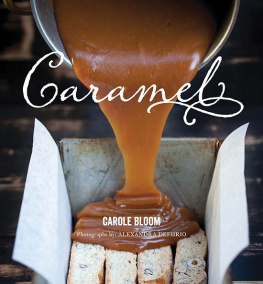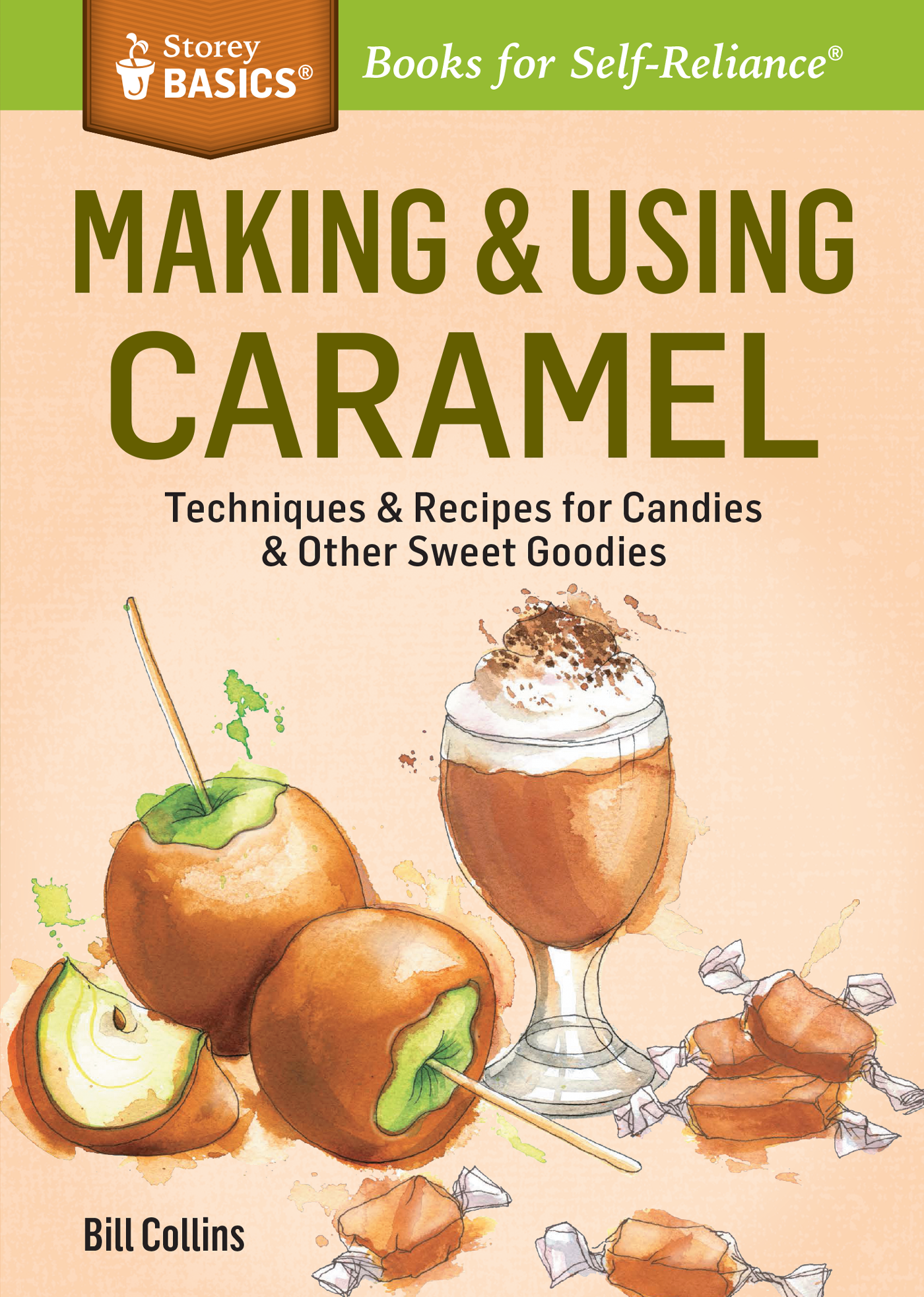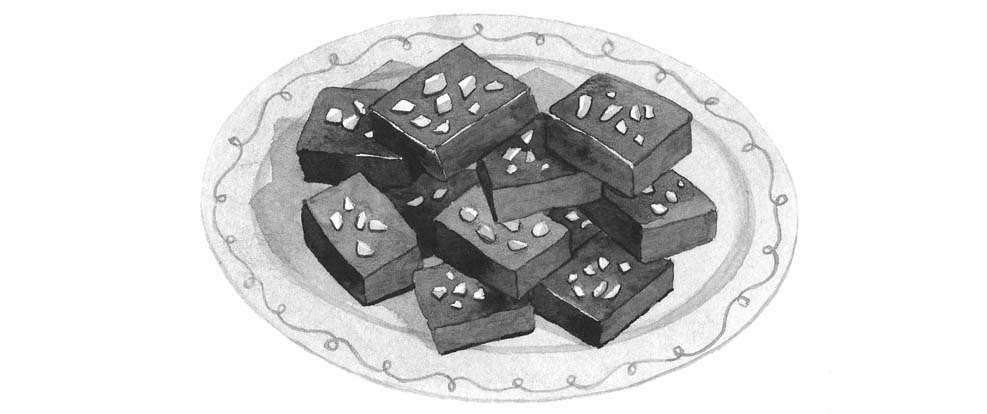Contents
To Karen, my favorite recipe tester.
Thanks to:
My family, friends, and neighbors, who endured all kinds of caramel samples and never complained.
Joan Parker, the worlds best literary agent.
Storey Publishing, and their never-ending patience as this book simmered like a fine caramel. In particular, Margaret Sutherland, Mollie Firestone, Nancy Ringer, Emily Spiegelman, and Tina Parent.
Everyone at Mass Appeal at WWLP in Springfield, including Michelle, Seth, Ashley, Denise, Deb, Sarah, Adam, Jason, Corey, Deb, and Mary. You make TV look easy.
The Cooking School at Stonewall Kitchen, in York, Maine.
Dr. Michael Palmer and Robin Broady, who inspire my writing every day.
Part One
Introduction to Caramel
What is caramel? Some people call it a chewy candy. Others describe it as a rich sauce for ice cream, the gooey center of a dark chocolate truffle, or the sweetest and crunchiest version of popcorn. Caramel is all that and more. No matter how you define it, homemade caramel is both simple and special.
Armed with a digital thermometer, a sturdy pot, and some helpful techniques, youll be able to create great caramel every time. The caramelizing process itself is simple: you heat sugar to a specific high temperature, so that it turns from light and opaque to a golden color to a deep brown. When you add cream and butter to the cooked sugar, you end up with a confection thats just amazing. But theres no need to stop there this book will also show you how caramelizing works its magic in pies, cakes, brownies, and even vegetables.
Essential Equipment
You wont need to buy any fancy equipment to make caramel. In fact, you may already have everything you need in your kitchen just waiting to be put to work.
Candy Thermometer
To get the desired results when youre making caramel, exact temperatures are important. Too low a temperature and youll get a dull, semi-tan puddle; too high and your burned, blackened mass will make a rock seem soft in comparison. Using a candy thermometer removes much of the temperature guesswork. My favorite type of candy thermometer is digital. You can get one for less than $25, and it should come with a clip so you can attach it to the side of the pot and monitor the rising temperature without holding onto the thermometer. Most digital thermometers also come with an alarm; you can set them to beep when your chosen temperature approaches so you know exactly when to take the caramel off the heat. Make sure the tip of the thermometer doesnt rest against the bottom of the pot (the pot itself is hotter than the liquid) or you wont get an accurate temperature reading.
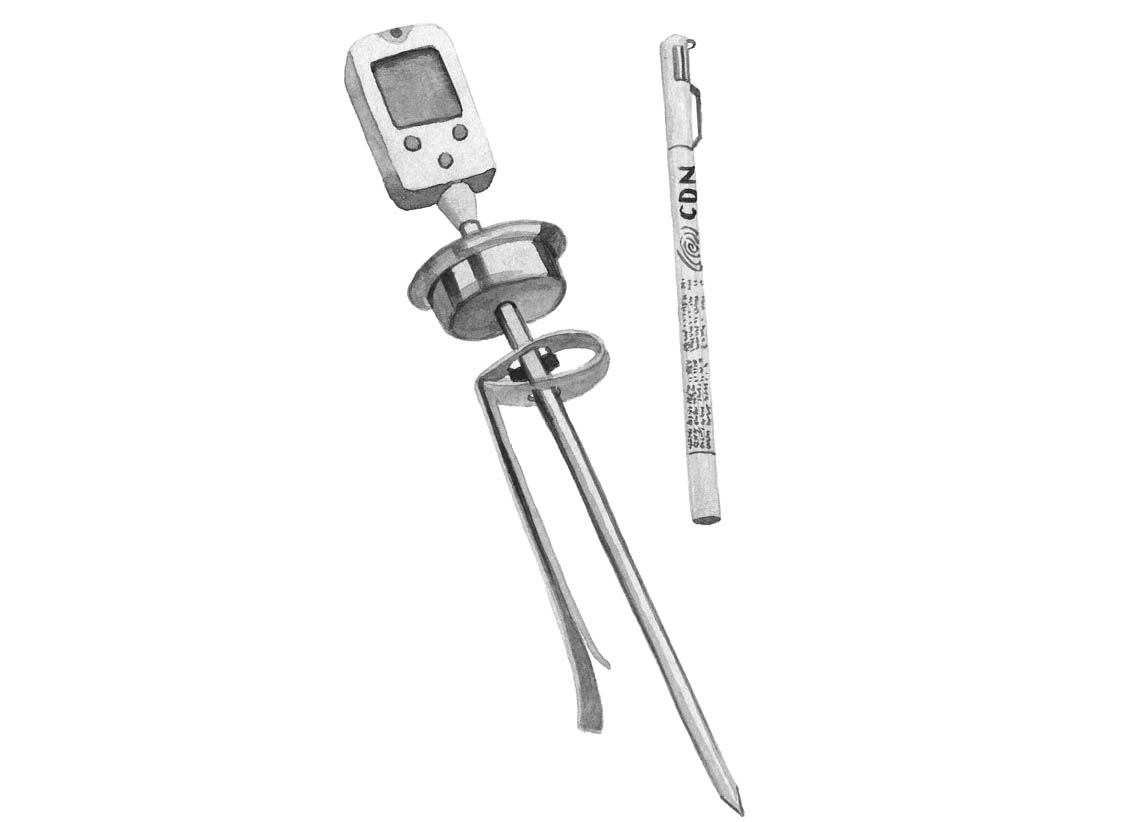
Hard crack: 300F to 310F. The sugar will form threads that break when bent. This is the highest temperature youll want for cooking with sugar; above this point the sugar mixture will burn, so make sure you remove the pan from the heat. This is the temperature for toffee and brittle (the word brittle refers to the texture and breakable nature of the candy).
A thermometer is the best way to determine that your caramel has reached the desired temperature. However, its also possible to test for any particular stage without a thermometer. Simply take a scant half teaspoon of the hot sugar (or sugary mixture) and put it into a glass of very cold water (you can add an ice cube if you dont think the water is cold enough). When it hits the water, the sugar will cool instantly, becoming gooey, hard as a rock, or somewhere in between, depending on its stage of cooking. This clever test will tell you what the texture of the sugar would be if you were to stop the cooking and cool the mixture. If you dont have a thermometer, this is a reliable test for doneness. If you do have a thermometer, then this is a fun way to confirm that your thermometer is correct and that youll have the desired outcome for the candys texture.
The Stages
When you heat sugar, its not just uncooked and then cooked sugar. Sugar goes through several identifiable stages, each with a name and corresponding temperature:
- Thread: 230F to 235F. This stage rarely comes up in candy making. Its such a low temperature that it mainly applies to a simple syrup, after the sugar has dissolved.
- Soft ball: 235F to 240F. The sugar will form a mushy, pliable ball. This is the stage for fudge and other confections with a fudge-like texture.
- Firm ball: 245F to 250F. The sugar will form a firm but still pliable ball. This is the stage for marshmallows.
- Hard ball: 250F to 265F. The sugar will form long threads. You can form a ball with it, but it will be barely pliable.
- Soft crack: 270F to 290F. The sugar will form threads that are barely flexible, bending just slightly. This is the stage for butterscotch.
A Large Heavy-Duty Saucepan or Stockpot
Just as important as the thermometer, a heavy-duty metal pot will evenly heat the caramel to its high temperature. Avoid thin, lightweight pots, which will increase your chances of burning the caramel. Nonstick pans arent a good choice either, as the nonstick surface often degrades over time whether from damage or just from wearing out and this can affect the flavor of the food youre cooking, especially at the high temperatures called for in making caramel.
As for size, I prefer an 8-quart saucepan or stockpot. This may seem large, but when you add the cream to the sugar, the very hot mixture will often bubble up in the pan and instantly (though temporarily) double or triple in volume. Using a large pot reduces the chance of the hot caramel bubbling over and causing injury or cleanup headaches. If you dont have an 8-quart pan, a 4- or 5-quart pan will also work. Just be extra cautious to keep the mixture from bubbling over the sides of the pan.
Stirring Utensils
Heatproof spatula: A spatula is the ideal tool for stirring the caramel and getting every last drop out of the saucepan or bowl. But just because a spatula is made of rubber doesnt mean that its heatproof. Check the package, or the spatula itself, to make sure it can withstand heat up to at least 400F.
Wooden spoon: You can use the back of a large wooden spoon (or an offset-handle spatula if you have one) to spread thin mixtures, such as toffee. And if you dont have a heatproof spatula, a wooden spoon can take its place for stirring and scraping. However, wooden spoons can sometimes introduce small amounts of moisture in the middle and later stages of cooking caramel, which can then trigger the creation of sugar crystals and cause your sugar mixture to seize. For this reason, the heatproof spatula is more reliable for making caramels.
Whisk: Called for in many recipes, a whisk will combine the ingredients much better and faster than a heatproof spatula or wooden spoon.
A Pastry Brush
A pastry brush, which is typically used for brushing sauce or an egg wash onto foods, has a special purpose when youre making caramels: when the sugar mixture is boiling, you will use a damp pastry brush to wash down the inside walls of the pan to prevent the sugar from crystallizing and seizing. A traditional bristle brush is a better choice than a silicone brush, which cant hold even a bit of water. Just make sure no bristles come off in the pan.

